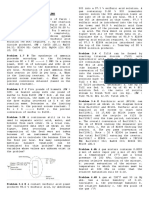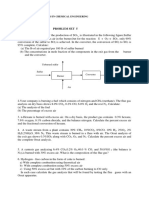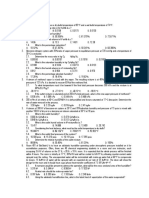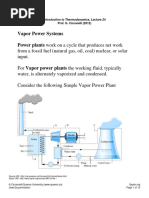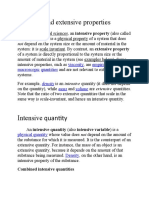0 ratings0% found this document useful (0 votes)
15 viewsCHE Calculations Questions 18-Mar-2023
CHE Calculations Questions 18-Mar-2023
Uploaded by
zedrickThis document contains 22 multiple choice questions about chemical engineering calculations. The questions cover topics like distillation, combustion, material and energy balances, and acid production. Correct answers are required for each calculation question.
Copyright:
© All Rights Reserved
Available Formats
Download as PDF, TXT or read online from Scribd
CHE Calculations Questions 18-Mar-2023
CHE Calculations Questions 18-Mar-2023
Uploaded by
zedrick0 ratings0% found this document useful (0 votes)
15 views6 pagesThis document contains 22 multiple choice questions about chemical engineering calculations. The questions cover topics like distillation, combustion, material and energy balances, and acid production. Correct answers are required for each calculation question.
Copyright
© © All Rights Reserved
Available Formats
PDF, TXT or read online from Scribd
Share this document
Did you find this document useful?
Is this content inappropriate?
This document contains 22 multiple choice questions about chemical engineering calculations. The questions cover topics like distillation, combustion, material and energy balances, and acid production. Correct answers are required for each calculation question.
Copyright:
© All Rights Reserved
Available Formats
Download as PDF, TXT or read online from Scribd
Download as pdf or txt
0 ratings0% found this document useful (0 votes)
15 views6 pagesCHE Calculations Questions 18-Mar-2023
CHE Calculations Questions 18-Mar-2023
Uploaded by
zedrickThis document contains 22 multiple choice questions about chemical engineering calculations. The questions cover topics like distillation, combustion, material and energy balances, and acid production. Correct answers are required for each calculation question.
Copyright:
© All Rights Reserved
Available Formats
Download as PDF, TXT or read online from Scribd
Download as pdf or txt
You are on page 1of 6
Chemical Engineering Calculations
Choose the best option.
1. The Reaumur temperature scale reads 0 °Reaumur at the freezing point of water and
80°Reamur at its boiling point. The temperature on this scale corresponding to absolute
zero is close to
A. -273 °Reaumur
B. -293 °Reaumur
C. -253 °Reaumur
D. -218 °Reaumur
E. -100 °Reaumur
2. A dryer is designed to evaporate a constant amount of water every hour. When the dryer
runs using 5 tons of feed per hour, a product weighing 3.4 tons and containing 11.6% water
was produced. If the product must not contain more than 4% water, calculate the amount
of feed required per hour.
A. 4.27 lb
B. 6.23 lb
C. 3.33 lb
D. 5.88 ln
E. none of these
Situation for questions 3 to 6
The feed to a distillation column consists of 10,000 lb/h of a liquid containing 45% benzene
and 55% toluene by mole, at 80°F. This is separated into a distillate of 99% by mole benzene
and a bottoms of 1.5% by mole benzene. The distillate is condensed at 179°F in the condenser.
After condensation, the liquid is cooled in the condenser to 170°F. The ΔH of condensation is
13,180 Btu/lbmole. The bottoms leave at 230°F. The ΔH of vaporization of the bottoms is
13,750 Btu/lbmole. The ratio of reflux returned to the column to the distillate removed is 8.1:1.
Heat is furnished by steam condensing at 270°F. Heat is removed by cooling water which rises
in temperature from 70 to 120°F. In the reboiler the vapor returned to the column is 3.64% by
mole benzene. The heat capacity of all the liquid streams may be assumed to be 38 Btu/lbmole-
°F.
3. Calculate the amount of distillate produced per hour.
A. 52.1 lbmol
B. 43.6 lbmol
C. 70.5 lbmol
D. 11.7 lbmol
E. None of these
4. The amount of top vapor entering the condenser per hour is
A. 422 lbmol
Prepared by: Engr. Heherson Cabrera
Chemical Engineering Calculations
B. 474 lbmol
C. 485 lbmol
D. 350 lbmol
E. None of these
5. Determine the mass of the steam required per hour. ΔHvap = 931.8 Btu/lb.
A. 4,000 lb
B. 5,155 lb
C. 1,388 lb
D. 7,480 lb
E. None of these
6. The amount in pounds of cooling water (Cp = 1 BTU/lb-°F) required per hour is close to
A. 75,000 lb
B. 128,200 lb
C. 100,000 lb
D. 250,000 lb
7. A solution containing 23% by mass Na3PO4 is cooled from 313 K to 298 K in a Swenson-
Walker crystallizer to form Na3PO4.12H2O. The solubility of Na3PO4 at 298 K is 15.5
kg/100 kg water, and the required flow of crystals is 0.063 kg/s. The mean heat capacity of
the solution is 3.2 kJ/kg-K and the heat of crystallization is 146.5 kJ/kg. If cooling water
enters and leaves at 288 and 293 K, respectively, and the overall coefficient of heat transfer
is 0.14 kW/m2-K, what length of crystallizer a required. Typical area available is 1 m2/m.
A. 9.2 m
B. 7.1 m
C. 11.0 m
D. 11.3 m
E. 10.0 m
8. A sample of gas from a boiler stack has been found to have the following composition:
75.66% N2, 10.24% CO2, 8.27% H2O, 5.75% O2, and 0.0825% SO2. Oil is used as fuel in
the plant. Deduce the most probable classification of the fuel oil.
A. No. 1
B. No. 2
C. No. 4
D. Low sulfur No. 6
E. High sulfur No. 6
Situation for questions 9 to 11
In a process for concentrating 1000 kg fresh orange juice containing 12.5 solids, the juice
is strained, yielding 800 g of strained juice and 200 kg pulpy juice. The strained juice is
concentrated in a vacuum evaporator to give an evaporated juice of 58% solids. The 200
kg pulpy juice is bypassed around the evaporator and mixed with the evaporated juice in
a mixer to improve the flavor. This final concentrated juice contains 42% solids.
Prepared by: Engr. Heherson Cabrera
Chemical Engineering Calculations
9. The amount of final concentrated juice in kilograms is closest to
A. 200 kg
B. 300 kg
C. 400 kg
D. 500 kg
E. 550 kg
10. Calculate the concentration of solids in the strained juice.
A. 5.0%
B. 6.5%
C. 7.1%
D. 10.0%
E. 10.8%
11. What is the concentration of solids in the bypass?
A. 25%
B. 34%
C. 27%
D. 38%
E. 40%
12. Formaldehyde (CH2O) is produced industrially by the catalytic oxidation of methanol
(CH3OH) by the following reaction:
CH3OH + 1/2O2 → CH2O + H2O
Unfortunately, under the conditions used to produce formaldehyde at a profitable rate, a
significant portion of the formaldehyde can react with oxygen to produce CO and H2O:
CH2O + 1/2O2 → CO + H2O
Assume that methanol and twice the stoichiometric amount of air needed for complete
oxidation of the CH3OH are fed to the reactor, that 90% conversion of the methanol results,
and that a 75% yield of formaldehyde occurs (based on the theoretical production of CH2O
by the first reaction). Determine the percentage of formaldehyde in the product gas.
A. 10.5%
B. 11.9%
C. 8.58%
D. 19.2%
E. None of these
13. One hundred moles of fuel with molar composition shown undergoes combustion with air.
H2S 6%
H2 5%
C3H8 57%
CO2 2%
C4H10 30%
Calculate the amount of required air in moles.
Prepared by: Engr. Heherson Cabrera
Chemical Engineering Calculations
A. 2,340 moles
B. 1,890 moles
C. 4,440 moles
D. 4,120 moles
Situation for questions 14 to 15
When a hydrocarbon-based fuel is burned in air, the Orsat analysis of the flue gas is 10.2% CO2,
1.0% CO, 8.4% O2, and 80.4% N2.
14. What is the hydrogen-to-carbon ratio in the fuel?
A. 0.20
B. 0.40
C. 0.60
D. 0.80
E. 1.00
15. Calculate the percent excess air.
A. 20%
B. 30%
C. 40%
D. 50%
E. 60%
Situation for questions 16 to 17
The table below shows coal analysis and needs to be completed. The analyses were all made on
the same coal, which has been air-dried.
Ultimate Proximate Modified Ultimate
C 78% wt FC 65% wt C
H 6 Moisture 4 Moisture
O VCM Combined H2O
N 3 Ash Net H
S 2 N+S
Ash 4 Ash
16. Calculate the % volatile combustible matter in the coal.
A. 18%
B. 27%
C. 31%
D. 35%
E. 40%
17. The percentage of combined water in the coal is close to
A. 0.56%
Prepared by: Engr. Heherson Cabrera
Chemical Engineering Calculations
B. 2.11%
C. 3.88%
D. 1.50%
E. 9.77%
18. Two hundred and fifty pounds per hour of 98% wt H2SO4 enters an absorption tower of a
contact sulfuric acid plant. If 20% oleum is produced in this tower, how many pounds per
hour of SO3 are absorbed?
A. 60 lb
B. 70 lb
C. 80 lb
D. 90 lb
E. 105 lb
Situation for questions 19 to 22
One hundred pounds per hour of pyrites containing 90% FeS2 and 10% gangue is charged to a
burner. Twenty percent excess air is to be used. The cinder contained gangue and Fe2O3 and no
sulfur, while the burner gas contains only SO2, N2, and O2. Ninety-eight percent of the SO2 is then
converted to SO3, and all the SO3 in the converter gas is absorbed by 80% H2SO4 solution. It is
desired to produce 100% H2SO4.
19. What is the percentage of SO2 in the burner gas?
A. 9.7%
B. 10.3%
C. 11.2%
D. 13.1%
E. None of these
20. What is the percentage of SO3 in the converter gas?
A. 6.8%
B. 9.9%
C. 7.2%
D. 1.3%
21. What is the percentage of SO2 in the absorber gas?
A. 0.01%
B. 0.11%
C. 0.22%
D. 0.28%
E. None of these
22. How many pounds of sulfuric acid is produced per 24-hour day?
A. 2,000 lb
B. 4,000 lb
C. 6,000 lb
Prepared by: Engr. Heherson Cabrera
Chemical Engineering Calculations
D. 7,500 lb
E. 8,000 lb
Prepared by: Engr. Heherson Cabrera
You might also like
- Sample Questions For Chemical EngineeringDocument36 pagesSample Questions For Chemical EngineeringChristopere DepasupilNo ratings yet
- Day 2 1 PDFDocument17 pagesDay 2 1 PDFChristianNo ratings yet
- ChE ReviewerDocument27 pagesChE ReviewerJohn Paul Rodriguez100% (2)
- Student Practice Questions For Chemical Engineering Calculations For CombustionDocument6 pagesStudent Practice Questions For Chemical Engineering Calculations For CombustionDonPedrew60% (5)
- Pure Substances and MixturesDocument1 pagePure Substances and MixturesCaryl Ann C. SernadillaNo ratings yet
- Fundamentals of Heat and Mass Transfer 7th Edition Incropera Solutions Manual20190709 74173 2j05lf PDFDocument20 pagesFundamentals of Heat and Mass Transfer 7th Edition Incropera Solutions Manual20190709 74173 2j05lf PDFAndiNo ratings yet
- Che Calculations 1 Set B July 10 2019Document2 pagesChe Calculations 1 Set B July 10 2019amielynNo ratings yet
- 40568Document14 pages40568Jelain HumarangNo ratings yet
- Calc 1 and 2 QuestionnaireDocument11 pagesCalc 1 and 2 QuestionnaireJoice Bundang ManingoNo ratings yet
- Slu - Sea - Che 520L Prelim Quiz 1Document2 pagesSlu - Sea - Che 520L Prelim Quiz 1onyxNo ratings yet
- She BoardDocument58 pagesShe BoardtreekyNo ratings yet
- Stoichiometry 2 StudentsDocument1 pageStoichiometry 2 StudentsGellene GarciaNo ratings yet
- CHE Calculations (Additional Problems)Document11 pagesCHE Calculations (Additional Problems)Karla IsraelNo ratings yet
- r050210803 Chemical Process CalculationsDocument8 pagesr050210803 Chemical Process CalculationsSrinivasa Rao GNo ratings yet
- Problem Set - Day 2 Chemical Engineering PrinciplesDocument26 pagesProblem Set - Day 2 Chemical Engineering PrinciplesLARRY JOHN COMPETENTENo ratings yet
- Exam Weekly Exam9Document7 pagesExam Weekly Exam9Astra BeckettNo ratings yet
- Combustion of Gaseous FuelsDocument5 pagesCombustion of Gaseous FuelscortezjesnerNo ratings yet
- CEP Refresher Problem Set5Document6 pagesCEP Refresher Problem Set5Alyssa Camille Malig-onNo ratings yet
- Gaseous FuelsDocument5 pagesGaseous FuelsShane PatulotNo ratings yet
- Checal 2 Module ProblemsDocument3 pagesChecal 2 Module Problems5zywgtdkw5No ratings yet
- CPC 9Document8 pagesCPC 9rajaraghuramvarmaNo ratings yet
- ChE PROF REFRESHER-COMPLETE - PPTX Version 1Document105 pagesChE PROF REFRESHER-COMPLETE - PPTX Version 1gotoudauedaNo ratings yet
- Untitled DocumentDocument3 pagesUntitled DocumentRoxan MoraNo ratings yet
- Chemical Engineering Principles-Che Mock Board Exam (3Rd Year)Document4 pagesChemical Engineering Principles-Che Mock Board Exam (3Rd Year)Ma Theresa CabiazaNo ratings yet
- Che 520L PQ1Document5 pagesChe 520L PQ1Shania Caroline CanaoNo ratings yet
- Problemario B.E. Segundo ParcialDocument4 pagesProblemario B.E. Segundo ParcialjorgeNo ratings yet
- Problem Set PPE Day 5Document4 pagesProblem Set PPE Day 5Reinzo GallegoNo ratings yet
- Problem SetsDocument2 pagesProblem Setsanjocyl aumentadoNo ratings yet
- Problems in Material BalanceDocument28 pagesProblems in Material BalanceKent GardoseNo ratings yet
- Lecture Notes 5A - Single-Phase System Exercise 1Document26 pagesLecture Notes 5A - Single-Phase System Exercise 1TaanzNo ratings yet
- DAY 28 - FUELS AND COMBUSTION L LECTURE PROBLEMSDocument2 pagesDAY 28 - FUELS AND COMBUSTION L LECTURE PROBLEMSj4240300No ratings yet
- Material BalanceDocument3 pagesMaterial BalanceermiasNo ratings yet
- Problem Set Mock Exam - CHE PDFDocument11 pagesProblem Set Mock Exam - CHE PDFBenzene100% (1)
- Problem Set Mock Exam CHEDocument11 pagesProblem Set Mock Exam CHEFroileth PulidoNo ratings yet
- Problem Set - Mock Exam - CHE PDFDocument11 pagesProblem Set - Mock Exam - CHE PDFleo besaNo ratings yet
- 22315-2023-Summer-Question-Paper (Msbte Study Resources)Document4 pages22315-2023-Summer-Question-Paper (Msbte Study Resources)hollowpurple156No ratings yet
- Fuel and CombustionDocument6 pagesFuel and Combustion123genrev100% (1)
- Combustion ProblemsDocument2 pagesCombustion ProblemsMary Grace Garcia100% (2)
- 07a30802 Chemical Process CalculationsDocument8 pages07a30802 Chemical Process CalculationsAshwin Nandagiri100% (1)
- Combustion PSETDocument3 pagesCombustion PSETGeloii PandaNo ratings yet
- Che Cal and Sepa ProblemsDocument4 pagesChe Cal and Sepa ProblemsPatricia Reign BagaoisanNo ratings yet
- Problem Set 7Document1 pageProblem Set 7Kyla Theresse SantosNo ratings yet
- Process_Calculation_1990_to_2024__1729579211494Document104 pagesProcess_Calculation_1990_to_2024__1729579211494toshirogaming27No ratings yet
- Chemical Engineering Calculations - Midterm ExamDocument12 pagesChemical Engineering Calculations - Midterm ExamJohnNo ratings yet
- Process Calculation Py Qs by Dev SirDocument97 pagesProcess Calculation Py Qs by Dev SirVIKAS SINGHNo ratings yet
- CPC QB Full 2013Document7 pagesCPC QB Full 2013Arul KamalakumarNo ratings yet
- ChE Refresher Without Answers PDFDocument86 pagesChE Refresher Without Answers PDFJulian S.No ratings yet
- PC Question Paper Nov 2021Document4 pagesPC Question Paper Nov 2021venkatesan sivaramuNo ratings yet
- CHE211 Problem Set 5Document3 pagesCHE211 Problem Set 5AlexNo ratings yet
- Set 1aDocument11 pagesSet 1aKIER GASGANo ratings yet
- Forstudents Mar4Document4 pagesForstudents Mar4RawlinsonNo ratings yet
- Quiz 7 Compre SP Class2014Document2 pagesQuiz 7 Compre SP Class2014LEXTER SOLISNo ratings yet
- Problem Set 1Document15 pagesProblem Set 1YanYan Carpio25% (4)
- Physical and Chemical PrinciplesDocument7 pagesPhysical and Chemical PrinciplesJr DocorNo ratings yet
- Soal Heat BalanceDocument5 pagesSoal Heat BalanceRfc KusyadiNo ratings yet
- Exam Weekly Exam5Document4 pagesExam Weekly Exam5Gab LibetarioNo ratings yet
- HWK Set 2 - CombustionDocument2 pagesHWK Set 2 - CombustionEliot KhNo ratings yet
- Synthetic Natural Gas: From Coal, Dry Biomass, and Power-to-Gas ApplicationsFrom EverandSynthetic Natural Gas: From Coal, Dry Biomass, and Power-to-Gas ApplicationsTilman J. SchildhauerNo ratings yet
- Process Steam Systems: A Practical Guide for Operators, Maintainers, and DesignersFrom EverandProcess Steam Systems: A Practical Guide for Operators, Maintainers, and DesignersNo ratings yet
- Encyclopaedia Britannica, 11th Edition, Volume 8, Slice 3 "Destructors" to "Diameter"From EverandEncyclopaedia Britannica, 11th Edition, Volume 8, Slice 3 "Destructors" to "Diameter"No ratings yet
- SS - AIATS - 02 (Main) - A - 2020-08-09 - 2020 - ADocument14 pagesSS - AIATS - 02 (Main) - A - 2020-08-09 - 2020 - AAditya SinghNo ratings yet
- TribometroDocument7 pagesTribometroRuben PurcaNo ratings yet
- Principles of Extractive Metallurgy - MSE 4201Document190 pagesPrinciples of Extractive Metallurgy - MSE 4201eyob100% (1)
- Unit5 ReviewPacket Ans2Document1 pageUnit5 ReviewPacket Ans2deckNo ratings yet
- Grade-8 (Science) Third QuarterDocument1 pageGrade-8 (Science) Third Quartertrexia autidaNo ratings yet
- Enterprise It Application (TTS1242-LAB) SESI: 0721 Semester 1 2021 Section 2Document4 pagesEnterprise It Application (TTS1242-LAB) SESI: 0721 Semester 1 2021 Section 2SITI SAHIRAHNo ratings yet
- (PR-999) TDS Thermal Etch ResistDocument2 pages(PR-999) TDS Thermal Etch Resistnithu17_4uNo ratings yet
- Laser: Challenging MCQ Questions by The Physics CafeDocument8 pagesLaser: Challenging MCQ Questions by The Physics CafeM. Danish JamilNo ratings yet
- Chapter 1: Atoms, Molecules and IonsDocument103 pagesChapter 1: Atoms, Molecules and IonsSyahir HamidonNo ratings yet
- Chapter 5 Acids Base EquilibriaDocument105 pagesChapter 5 Acids Base Equilibriantranh58No ratings yet
- Ethylene PipesDocument8 pagesEthylene Pipesingbarragan87No ratings yet
- Biochem - Enzymes Report ScriptDocument5 pagesBiochem - Enzymes Report ScriptIan IglesiaNo ratings yet
- ME103 6.1 - Ciccarcelli - Introduction To Thermodynamics - Lecture 24Document13 pagesME103 6.1 - Ciccarcelli - Introduction To Thermodynamics - Lecture 24Adhitya ReNo ratings yet
- Practical Experiment Grade 9Document14 pagesPractical Experiment Grade 9Ratul RanjanNo ratings yet
- Engineering Chemistry (BCHY101L) : Energy DevicesDocument84 pagesEngineering Chemistry (BCHY101L) : Energy DevicesDeepali Mishra 21BCE3440No ratings yet
- Kuliah I: Teknologi Polimer Maju: About This CourseDocument14 pagesKuliah I: Teknologi Polimer Maju: About This CourseIlham Kiki ShahilaNo ratings yet
- Helium Hydride IonDocument7 pagesHelium Hydride IonMihai Iulian PăunescuNo ratings yet
- Module 3Document2 pagesModule 3Christian James DomingoNo ratings yet
- Chemistry Igcse 0620 October 2023 Paper 6 Variant 3Document7 pagesChemistry Igcse 0620 October 2023 Paper 6 Variant 3sally.mansterlyNo ratings yet
- Unit Cell Cubic StructuresDocument8 pagesUnit Cell Cubic StructuresGuilherme Dos Santos MoreiraNo ratings yet
- Rates of Heat Transfer Example ProblemDocument2 pagesRates of Heat Transfer Example ProblemleonNo ratings yet
- Catalyst Deactivation1Document8 pagesCatalyst Deactivation1Hussain AliNo ratings yet
- PH4211 Statistical Mechanics: Problem Sheet 2 - AnswersDocument14 pagesPH4211 Statistical Mechanics: Problem Sheet 2 - AnswersRoy VeseyNo ratings yet
- "H Ehlllllei M Leelhellllle Elhllllllhllll Llllllllmllllu LlllllllhlllluDocument624 pages"H Ehlllllei M Leelhellllle Elhllllllhllll Llllllllmllllu Llllllllhllllushishko106No ratings yet
- Properties of HVOF CoatingDocument9 pagesProperties of HVOF Coatingsuresh_501No ratings yet
- Elements and CompoundsDocument16 pagesElements and CompoundsMollel TajiriNo ratings yet
- Intensive and Extensive PropertiesDocument10 pagesIntensive and Extensive PropertiesArvz Vash ArcadioNo ratings yet
- Area Target TutorialDocument20 pagesArea Target TutorialJennifer ShawNo ratings yet









































